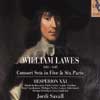Lawes Consort Sets in Five and Six Parts
An attractive anniversary celebration
View record and artist detailsRecord and Artist Details
Composer or Director: William Lawes
Genre:
Chamber
Label: Alia Vox
Magazine Review Date: 9/2002
Media Format: CD or Download
Media Runtime: 0
Mastering:
Stereo
DDD
Catalogue Number: AV9823

Tracks:
| Composition | Artist Credit |
|---|---|
| Consort Sett a 5 |
William Lawes, Composer
Hespèrion XXI Jordi Savall, Viola da gamba William Lawes, Composer |
| Consort Sett a 6 |
William Lawes, Composer
Hespèrion XXI Jordi Savall, Viola da gamba William Lawes, Composer |
Author:
Jordi Savall’s Hespèrion XXI joins Phantasm (Channel Classics‚ 8/02) and Concordia (Metro nome‚ 8/02) in celebration of William Lawes’s 400th birthday. This beautifully packaged twodisc set offers listeners all 10 of the five and sixpart consort sets‚ which seem to date from the 1630s. The fivepart works are performed on four viols with organ and the sixpart with the addition of two violins. Neither Phantasm nor Concordia include any of the fivepart sets on their discs‚ and neither employ violins in the sixpart sets‚ so there are no direct comparisons; however‚ there are observations to be made about the effect of using one combination of instruments or another.
Lawes provided parts for five viols and organ in the first instance and six viols and organ in the second. For the sixpart sets‚ Laurence Dreyfus of Phantasm informs listeners that the autograph score specifies only viols and that the separate organ part isn’t always consistent with it. So while Mark Levy’s Concordia use an organ‚ they incorporate it in lieu of‚ rather than in addition to‚ one of the bass viols. Jordi Savall’s Hespèrion XXI perform the fivepart sets similarily‚ with four viols and organ. But in the sixpart works‚ Savall takes his cue from Lawes’s ‘Royall’ consorts (scored for two each of violins‚ bass viols and theorbos) and brings in two violins to augment the four viols and organ. In 1630s England‚ the combination of violins with viols would have seemed ‘modern’ and even foreign. Indeed in the booklet essay David Pinto‚ who edited the five and sixpart consort sets (1979)‚ invites readers to compare these works with Monteverdi’s Madrigali Guerrieri et Amorosi (1638).
Hardly surprisingly‚ the absence of organ in the Phantasm performances allows the viol players greater mobility and subtlety of effect; listeners have no difficulty hearing individual parts. The presence of an organ in the Concordia and Hespèrion recordings blends and sustains the ensemble sound‚ enriching its resonance and‚ in particular‚ introducing a flutey timbre in the upper register (listen‚ for example‚ to the G minor Aire on disc 1). It’s a lush‚ attractive sound‚ but the performances are inevitably less lithe (their tempi tend to be slower than Phantasm’s). Dreyfus views the organ part as didactic and intended primarily to underpin performances by amateurs. His reluctance to use them‚ except as a source for his own edition‚ is borne out by the distortion effect encountered in certain tracks of the Hespèrion recording (the A minor Fantazia No 1 on disc 1 and the C minor Inomine on disc 2) – although Concordia do not fall victim to this effect‚ perhaps because they tend to eschew the luxuriance of sound cultivated by Hespèrion.
Savall’s use of violins in the sixpart sets presumably enjoys the tacit approval of David Pinto‚ and it is an attractive sound. But it is a different sound‚ more orchestral than that of the reedy viol consort. The violins add brightness‚ even brittleness‚ to the treble parts (listen to the C major Fantazy No 1 or the B flat major Fantazia)‚ and even distract the ear by tending to polarise textures between treble and bass (how very Baroque!). The G minor Pavan provides a striking case in point.
As with many of Savall’s otherwise excellent recordings‚ I find this one rather enervatingly introspective. The focus is too often on the pulse rather than the transcendental architectural qualities of what he rightly calls ‘one of the most original masterpieces of chamber music of all time’.
Discover the world's largest classical music catalogue with Presto Music.

Gramophone Digital Club
- Digital Edition
- Digital Archive
- Reviews Database
- Full website access
From £8.75 / month
Subscribe
Gramophone Full Club
- Print Edition
- Digital Edition
- Digital Archive
- Reviews Database
- Full website access
From £11.00 / month
Subscribe
If you are a library, university or other organisation that would be interested in an institutional subscription to Gramophone please click here for further information.




